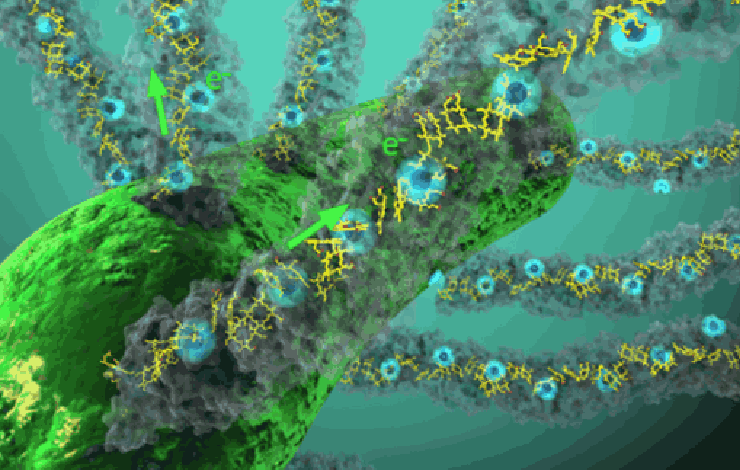20-04-2023

Na foto: pormenor da Imagem da bactéria do género Geobacter (verde) e dos seus filamentos condutores (cinzento) formados por polímeros de citocromos, com vários grupos hemo (amarelo), que criam um caminho contínuo para o transporte de eletrões (azul).
The rising temperatures threatening life on our planet are caused in part by microbes that produce 50% of atmospheric methane, a gas 30 times more potent than CO2 at trapping heat. Surprisingly, another kind of microbe combats these rising temperatures by consuming up to 80% of methane released from ocean sediments. How are some microbes methane producers and others methane consumers?
To solve this puzzle, an international team of researchers have received one of the 25 "Human Frontier Science Program Awards" for cutting edge, high-risk high-reward with an amount of $1.500,000. Carlos Salgueiro, leader of the Biochemistry and Bioenergetics of Heme Proteins Lab at UCIBIO-NOVA is one of the researchers of this team, together with Nikhil Malvankar (Yale University, USA), Lisa Craig (Simon Fraser University, Canada) and Olivera Francetic (Institut Pasteur, France).
The team will study the wire-like filaments made by electricity-producing Geobacter, which resemble methane-eating microbes. These “nanowires” allow microbes to exchange electrons with their partners, with the direction of current determining whether methane is produced or consumed.
Nanowires were first reported over two decades ago and until very recently were thought to be type IV pili. However, Malvankar lab recently revealed that the conductive filaments of Geobacter are in fact polymers of cytochrome proteins, which contain metal-coordinating hemes that line up to create a continuous path along which electrons travel. The role of the Geobacter pili may actually be to assemble and secrete these cytochrome nanowires.
The team’s collective expertise in nanowires (Malvankar), heme proteins (Salgueiro), type IV pili (Craig) and bacterial secretion (Francetic) will help unravel how the complex pilus machinery helps microbes produce nanowires.